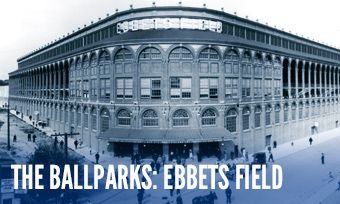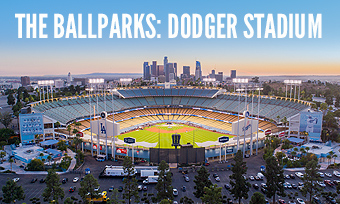THE TEAMS
Los Angeles Dodgers
Known as the Brooklyn Trolley Dodgers, 1884-88; Brooklyn Bridgegrooms, 1889-98; Brooklyn Superbas, 1899-1910; Brooklyn Dodgers, 1911-13, 1932-57; Brooklyn Robins, 1914-31
THE DODGERS BY THE DECADE
The 19th Century
Born out of a borough rich in early baseball activity, the Dodgers started as a minor league outfit and, after winning the Interstate League title in 1883, moved up to the American Association a year later. They won their first pennant in their last season in the AA (in 1889) and then another a year later during its maiden National League campaign after making yet another move. Hopes for further success were fleeting until 1899, when the franchise was infused with front-office and on-field talent from the Baltimore Orioles, a NL powerhouse from earlier in the decade.
The 1900s
The Superbas began the century in style with a National League pennant in 1900, but were hit hard by the player raids of the upstart American League, descending the team into a series of subpar (if not worse) finishes. By mid-decade, Charles Ebbets had secured complete ownership of the franchise and went about locating a spot for a proposed steel-and-concrete ballpark to replace the wooden Washington Park.
The 1910s
Historic Ebbets Field opened in 1913 without initially translating into big attendance gains, but at least the team began a rebound in the standings. Wilbert Robinson, a long-time coach (and former friend) of New York Giants manager John McGraw, took over at the helm in 1914 and within three years produced a pennant thanks to a renaissance of former star pitchers (Jack Coombs, Rube Marquard) and the emergence of polite but dangerous hitter Zack Wheat.
The 1920s
The Robins began the decade on a strong note by clinching their second NL pennant in five years, and once again fell short in the World Series. Some respectable campaigns followed in advance of a solid stretch of disappointment, as the Robins developed a boneheaded reputation for zany antics (intentional or not) that led to their being called the Daffiness Boys. All this, despite some of the league’s best pitching talent (led by Dazzy Vance and legal spitballer Burleigh Grimes) in a time ripe with lively hitting.
The 1930s
Amid front office turmoil, Robinson stepped away after 18 years and with him went the name; Brooklyn became the Dodgers once more, but a trail of losing seasons made the franchise the heel of New York baseball as the crosstown Giants and New York Yankees thrived. Everything changed late in the decade with the brilliant and combustible pairing of powerful general manager Larry MacPhail and in-your-face manager Leo Durocher—both of whom would gang up to exorcise the clownish image and ignite a longstanding winning tradition.
The 1940s
Blossoming into a powerhouse, the Dodgers won three pennants—but ran their World Series losing streak to five as they lost each time to the Yankees. MacPhail left and was replaced by renowned St. Louis executive Branch Rickey—who made history at the end of 1945 by signing Jackie Robinson as the century’s first black player in organized “white” baseball. Robinson made his historic Dodgers debut in 1947, leading a rush of recruits that included Duke Snider, Gil Hodges and black pitcher Don Newcombe; attendance surged at Ebbets Field, often approaching two million fans a year.
The 1950s
The glory of Brooklyn baseball reached its peak early in the decade as the Boys of Summer reigned, with Robinson, Snider and three-time NL MVP Roy Campanella sparking a lively offense at comfy Ebbets Field. After losing two more World Series to the Yankees in 1952-53, the Dodgers at long last won it all in 1955, conquering the Bronx Bombers with a memorable seven-game classic. But success on the field wasn’t enough for Dodgers owner Walter O’Malley, who maxed out on revenue at Ebbets and wanted more; he would have to move the team to Los Angeles to get it, breaking far too many hearts in the Borough he left behind.
The 1960s
The Dodgers’ success skipped nary a beat in California, as the team settled into beautiful Dodger Stadium in coveted Chavez Ravine near downtown Los Angeles in 1962. The personality of the team performed a coast-to-coast transformation, no longer built on slugging power but, instead, on stifling pitching that more than offset a popgun offense. Leading the way was the unmatchable Sandy Koufax, who arguably produced the single greatest run of pitching ever seen—coinciding with three pennants and two world titles over a four-year stretch at mid-decade.
The 1970s
Long-time manager Walter Alston ceded to the boisterous Tommy Lasorda and the Dodgers continued their winning ways, restoring the balance on offense with a homegrown infield (Steve Garvey, Bill Russell, Davey Lopes and Ron Cey) that stuck together for a record eight years and lent long-overdue backbone to the pitching staff, which remained in top shape thanks to aces Andy Messersmith and Don Sutton. An old problem cropped up in the postseason: A failure to win, often against the Yankees—who prevailed over the Dodgers in 1977-78.
The 1980s
The Dodgers pulled together two World Series triumphs seven years apart under entirely different circumstances in a decade dogged by inconsistency. Fueled by Mexican sensation Fernando Valenzuela, the Dodgers overcame the Yankees in strike-ravaged 1981 for one world title and, after some thin years that led to a forced embracement of free agency, shocked heavily-favored Oakland in 1988 thanks to the pitching magnificence of Orel Hershiser and the painful heroics of Kirk Gibson, whose highly unlikely, classic game-winning homer in Game One set a definitive tone for the upset.
The 1990s
The stability of the franchise that had come to define the Dodgers—on the field and off—began to lose its glue, with Lasorda stepping down after 21 years and the O’Malley family cashing out after a half-century of ownership; media kingpin Rupert Murdoch bought in for what would be a short-lived and unsuccessful run. Still, the Dodgers remained competitive on the field, reaching the postseason three times (with no success) thanks to the impressive hitting of catcher Mike Piazza, a godson of Lasorda.
The 2000s
The Dodgers began the new century continuing to fill up aging-with-grace Dodger Stadium and playing winning (if not dominant) baseball, with yet another round of home-schooled talent starting with superlative closer Eric Gagne (who racked up a record 84 straight saves without blowing one) followed by slugger Matt Kemp and future ace Clayton Kershaw. Manny Ramirez’s brief (and tumultuous) stay in Los Angeles brought the Dodgers to the brink of two straight World Series appearances at decade’s end.
The 2010s
Major trouble brewed in the front office when owner Frank McCourt, crippled by divorce, drove the team deep into debt and declared bankruptcy in 2011. He came out a billionaire a year later when he sold the Dodgers for a record $2.15 billion to Guggenheim Partners, who weren’t shy spending money in an attempt to restore Dodger greatness—but rather than grab the best players money can buy, the team shrewdly built mostly from within as it harvested a fertile farm system. With elite ace Kershaw hitting full stride as, arguably, the greatest pitcher in franchise history, the Dodgers won seven straight NL West titles to close out the decade—but championship glory remained elusive as the team could only grab two NL pennants, leading to World Series defeat each time.
The 2020s
Flush with almost limitless money, the Dodgers further strengthened not by dipping into the farm but poaching from outside the gates, bringing in All-Star talent in Mookie Betts, Freddie Freeman and Shohei Ohtani. Along with an uncannily stingy pitching staff from which coaches turned water into wine, the Dodgers hit juggernaut mode—winning at an historically unparalleled rate. The only disappointment was that the team, favored to win it all virtually every year, didn’t—nevertheless settling for long-overdue world titles in 2020 and 2024.
Highlights of the Dodgers’ History on This Great Game:
 1916: A Test of Robins Brooklyn manager Wilbert Robinson takes on former pal and current foe John McGraw for the National League pennant.
1916: A Test of Robins Brooklyn manager Wilbert Robinson takes on former pal and current foe John McGraw for the National League pennant.
 1941: 56, .406 and Dem Bums Joe DiMaggio’s magical hitting streak, Ted Williams’ run at .400 and the rise of the Dodgers result in one of baseball’s most memorable years.
1941: 56, .406 and Dem Bums Joe DiMaggio’s magical hitting streak, Ted Williams’ run at .400 and the rise of the Dodgers result in one of baseball’s most memorable years.
 1947: The Arrival of Jackie Robinson Baseball’s color barrier is knocked down, but not without intense prejudicial resistance.
1947: The Arrival of Jackie Robinson Baseball’s color barrier is knocked down, but not without intense prejudicial resistance.
 1955: Next Year at Last At long last, the Brooklyn Dodgers secure their first—and only—world championship.
1955: Next Year at Last At long last, the Brooklyn Dodgers secure their first—and only—world championship.
 1958: And Now, From Coast to Coast The Dodgers and Giants break the hearts of New Yorkers everywhere and head west to California.
1958: And Now, From Coast to Coast The Dodgers and Giants break the hearts of New Yorkers everywhere and head west to California.
 1959: Reinventing Dodger After a lackluster California debut, the Los Angeles Dodgers victoriously adapt to their new surroundings.
1959: Reinventing Dodger After a lackluster California debut, the Los Angeles Dodgers victoriously adapt to their new surroundings.
 1963: The Sandman Cometh After years of wildness and frustration, the Los Angeles Dodgers’ Sandy Koufax becomes an ace for the ages.
1963: The Sandman Cometh After years of wildness and frustration, the Los Angeles Dodgers’ Sandy Koufax becomes an ace for the ages.
 1988: Roy Hobbs in Dodger Blue Kirk Gibson makes like Robert Redford and gives the Los Angeles Dodgers a storybook ending.
1988: Roy Hobbs in Dodger Blue Kirk Gibson makes like Robert Redford and gives the Los Angeles Dodgers a storybook ending.
 2024: Best of Sho The incomparable Shohei Ohtani joins the Los Angeles Dodgers, injecting strength and promise into their elusive championship ambitions.
2024: Best of Sho The incomparable Shohei Ohtani joins the Los Angeles Dodgers, injecting strength and promise into their elusive championship ambitions.





